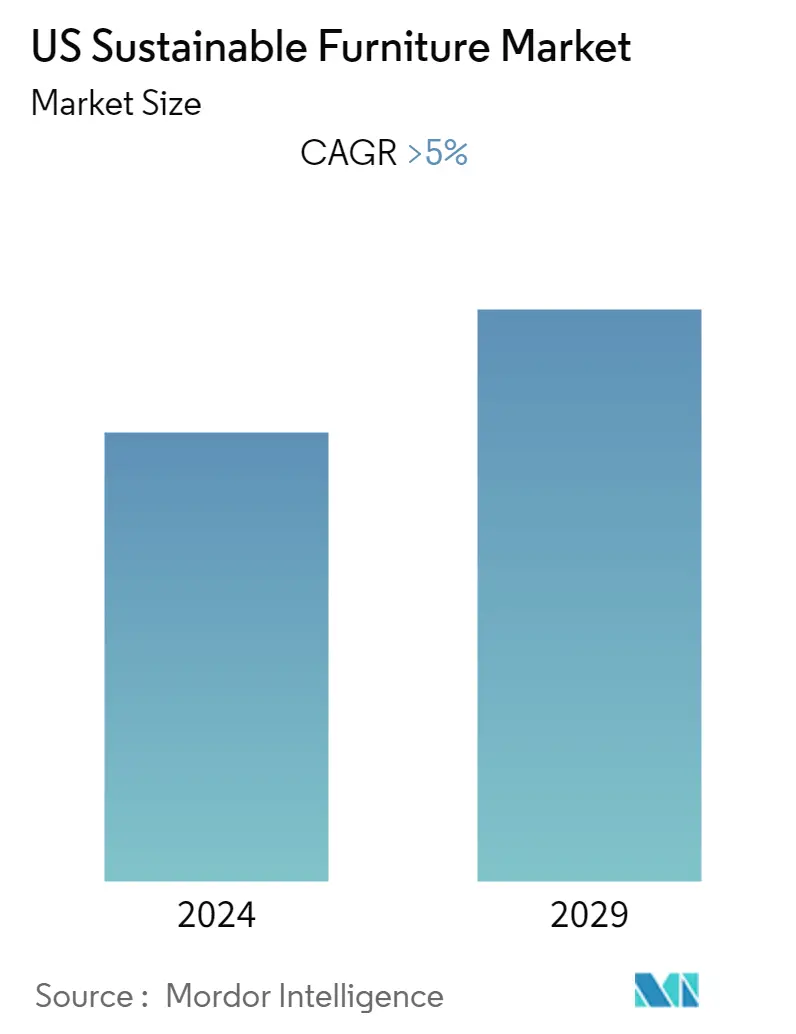Market Size of US Sustainable Furniture Industry

| Study Period | 2020 - 2029 |
| Base Year For Estimation | 2023 |
| Forecast Data Period | 2024 - 2029 |
| Historical Data Period | 2020 - 2022 |
| CAGR | > 5.00 % |
| Market Concentration | Medium |
Major Players
*Disclaimer: Major Players sorted in no particular order |
US Sustainable Furniture Market Analysis
The COVID-19 pandemic has forced millions of Americans to work from home as a result of social norms that discourage remote labour. Working professionals without access to comfortable furniture find working from home (WFH) to be stressful. WFH has become the norm and is anticipated to remain so for the foreseeable future. Due to people's desire to study and work from home, as well as their desire for hygienic furniture during the COVID-19 pandemic, sales of sustainable furniture have surged.
The demand for sustainable furniture is increasing primarily as a result of consumers growing knowledge of the value of sustainable living. This entails using less fuel and recycling scrap wood. For instance, Herman Miller has committed to zero waste, 50% more local renewable energy (50,000 MWh), 100% DfE-approved products, and 125,000 tonnes of product returns annually.
Additionally, ecommerce businesses are expanding to cut down on the need for inventory and rental space. Amazon.com and Wayfair are two of the most well-known e-commerce sites in the US for furniture. The demand for sustainable furniture increased as a result of the increasing opportunities for furniture sales via online channels, which compelled online retailers to improve their purchasing procedures in terms of security and dependability. A few of the policies that entice customers to shop online include secure transactions, cash-on-delivery options, prompt return policies, and integrated and centralised customer service.
US Sustainable Furniture Industry Segmentation
Sustainable furniture, is an emerging concept, and largely includes furniture made from eco-friendly or recycled materials that are sustainably sourced. Some of the prevalent raw materials used for green furniture include recycled textiles, oak, birch, hemp, wood, and bamboo. A complete analysis of the US Sustainable Furniture Market, which includes an assessment of the emerging market trends by segments, significant changes in the market dynamics, and the market overview is covered in the report. The US Sustainable Furniture Market is Segmented By Application (Home Furniture, Office Furniture, Hospitality Furniture, Other Furniture), By Material (Wood, Bamboo, PET, Others), By Distribution Channel (Offline, Online).
| By Application | |
| Home Furniture | |
| Office Furniture | |
| Hospitality Furniture | |
| Other Furniture |
| By Material | |
| Wood | |
| Bamboo | |
| PET | |
| Others |
| By Distribution Channel | |
| Offline | |
| Online |
US Sustainable Furniture Market Size Summary
The US sustainable furniture market is experiencing significant growth, driven by the increasing trend of remote work and heightened consumer awareness of sustainable living practices. The COVID-19 pandemic has accelerated the demand for comfortable and hygienic furniture, as more individuals work from home. This shift has led to a surge in sales of sustainable furniture, as consumers prioritize eco-friendly options that reduce waste and utilize recycled materials. Companies like Herman Miller are leading the charge with commitments to sustainability, such as zero waste and renewable energy initiatives. The rise of e-commerce has further bolstered this market, with platforms like Amazon and Wayfair enhancing their online shopping experiences to meet the growing demand for sustainable furniture.
The residential sector dominates the US sustainable furniture market, with consumers increasingly opting for stylish and high-quality products that align with their sustainable values. This trend is supported by higher disposable incomes and a shift away from single-use plastics in interior decorating. The market is expected to continue its upward trajectory, with both domestic sales and international exports strengthening. Major players like Ashley Furniture and Wayfair Inc. hold significant market shares, but technological advancements and product innovations are allowing smaller companies to expand their presence. The market's growth is further evidenced by strategic expansions and new store openings, such as Wayfair's plans to establish new engineering sites and Ashley's showroom launch in Mexico.
US Sustainable Furniture Market Size - Table of Contents
-
1. MARKET INSIGHTS AND DYNAMICS
-
1.1 Market Overview
-
1.2 Market Drivers
-
1.3 Market Restraints
-
1.4 Value Chain Analysis
-
1.5 Porter's Five Forces Analysis
-
1.5.1 Threat of New Entrants
-
1.5.2 Bargaining Power of Buyers
-
1.5.3 Bargaining Power of Suppliers
-
1.5.4 Threat of Substitutes
-
1.5.5 Intensity of Competitive Rivalry
-
-
1.6 Insights into Latest Trends and Technological Advancements in the Industry
-
1.7 Insights on Government Policies and Industry Regulatory Framework/Standards
-
1.8 Insights on Industry Certifications
-
1.9 Consumer Behavior Analysis and Preferences
-
1.10 Impact of COVID-19 on the Market
-
-
2. MARKET SEGMENTATION
-
2.1 By Application
-
2.1.1 Home Furniture
-
2.1.2 Office Furniture
-
2.1.3 Hospitality Furniture
-
2.1.4 Other Furniture
-
-
2.2 By Material
-
2.2.1 Wood
-
2.2.2 Bamboo
-
2.2.3 PET
-
2.2.4 Others
-
-
2.3 By Distribution Channel
-
2.3.1 Offline
-
2.3.2 Online
-
-
US Sustainable Furniture Market Size FAQs
What is the current US Sustainable Furniture Market size?
The US Sustainable Furniture Market is projected to register a CAGR of greater than 5% during the forecast period (2024-2029)
Who are the key players in US Sustainable Furniture Market?
Ashley Furniture, Inter Ikea Systems B.V., Bed Bath and Beyond Inc., Williams Sonoma Inc., Way Fair Inc. and Target Corporation are the major companies operating in the US Sustainable Furniture Market.

